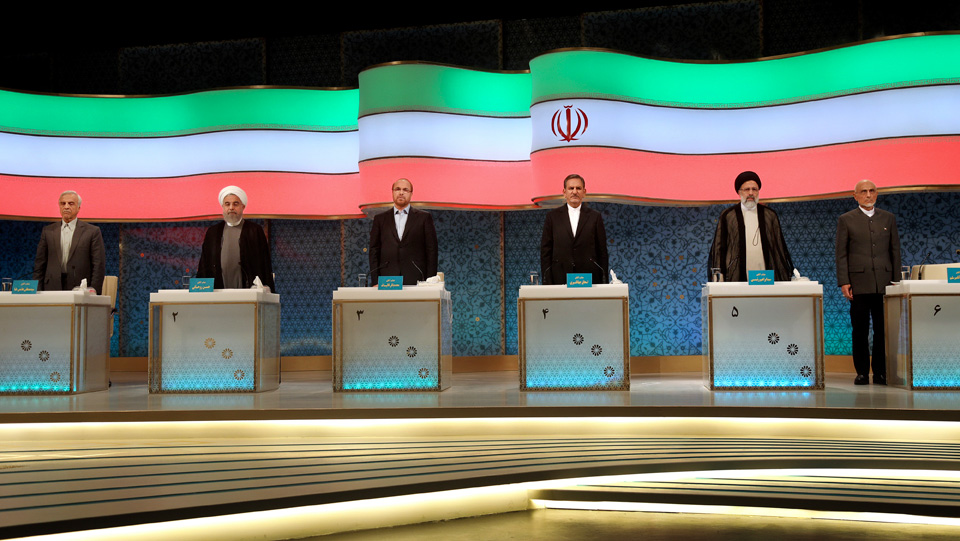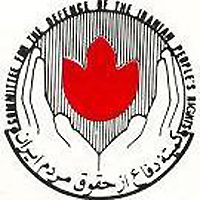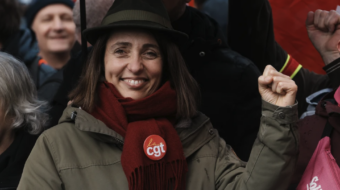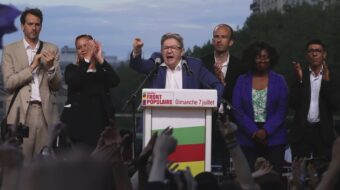
Heralded as a reformer by certain sections of the Western press, current Iranian President Hassan Rouhani has spent four years in office without doing a thing to improve the human rights record of the Iranian regime.
Rouhani has done nothing to support the development of trade unions or advance the position of women in Iranian society. His neoliberal economic policies have meant rampant inflation and soaring unemployment.
Despite this, Rouhani will be seeking a further four years in office. He will not be standing on a platform of extending the misery of the Iranian people, though this is a likely outcome, but as the man who delivered an end to international sanctions through the 5+1 deal with the United States and European Union.
The deal, whereby international sanctions will be softened in exchange for Iran accepting strict controls on its nuclear energy program, was barely bedded in when the U.S. electorate returned Donald Trump as president.
Trump has been a vociferous opponent of the deal with Iran and, if his foreign policy concerns were not already overburdened, with air strikes on Syria, bombing Afghanistan, and the developing face-off with North Korea, rewriting the terms of the deal may have been further up his agenda.
Which is not to say that Trump will not return to the subject of Iran. No doubt he will.
This inevitably means that the forthcoming presidential elections in Iran will be shaped by the question of which candidate will come out best in any dealings with the U.S. president over the next four years.
Who will face Trump?
Under the Iranian presidential system, only the powerful Guardian Council can approve candidates for the presidency or any other key political office. The Guardian Council itself is under the firm grip of the Supreme Leader, Ayatollah Ali Khamenei, thus ensuring that the ruling theocracy has a firm hold on the “democratic” process.
Rouhani’s cards are already on the table. The more conservative elements in the clergy have fielded little known Ayatollah Ebrahim Raisi.
Regarded by many as a likely successor to Khamenei, but lacking experience at political executive level, the presidency is seen as possibly paving the way for Raisi to take over as Supreme Leader.
With Khamenei rumored to be in the advanced stages of prostate cancer, the need to locate a successor may come sooner than anticipated.
Raisi as a candidate does not come without problems for the regime, bringing his own significant baggage. Although little known as a politician, he does have a reputation as a “hanging judge,” particularly in relation to the massacre of thousands of the regime’s opponents in an especially brutal episode in 1988.
The commemoration of the executions, known as the “national catastrophe,” is a significant event taking place each September in Iran and the diaspora abroad, and Raisi’s role in this atrocity was prominent.
Raisi has been named as one of the members of the committee of four judges that oversaw these executions of political prisoners, labelled as one of the “crimes of the century” by the late Grand Ayatollah Montazeri.
There have been a number of legal cases opened against the committee and those complicit in various countries around the world, including Canada, which has recognized the 1988 executions as a crime against humanity.
There is a realistic prospect that if Raisi is elected to the presidency, there would be significant barriers to his free movement abroad, including the risk of possible arrest for his role in these crimes.
Most observers believe that Rouhani has a better chance of securing a second term, based on the fact that the Iranian leadership will want to continue the normalization of diplomatic relations and co-operation with the E.U. and U.S.
They will want to see the sanctions lifted and thus remove an immediate existential threat to the survival of the regime.
A Rouhani administration is seen as a grouping of mainly able technocrats, many educated in Britain and the U.S., who are best placed to oversee this process of detente. The attitude of the Trump administration remains a potential barrier to this strategy.
However, it is worth noting that on April 24 Khamenei was quoted on Iranian state television as saying that “candidates should promise to focus on national capabilities and domestic capacities to resolve the economic issues…rather than looking abroad” – in effect distancing himself from one of the pillars of Rouhani’s platform, if not throwing his outright endorsement behind those advocating a more hardline stance.
Previously, on April 20, the Guardian Council moved to disqualify the candidacy of the controversial former president Mahmoud Ahmadinejad, following much conjecture and unrest in the wake of his putting himself forward quite unexpectedly.
The next day, the regime revealed the rest of the final shortlist to be made up by Mohammad-Bagher Ghalibaf, mayor of Tehran, former commander of the Revolutionary Guards and closely associated with the Raisi faction; Eshaq Jahangiri, first deputy and close ally of Rouhani; and relatively low-profile though fundamentalist politicians, Mostafa Agha Mirsalim and Mostafa Hashemi-Taba.
Thus, regardless of the eventual outcome of the election, there is certainly little cause for hope or optimism among the Iranian people.
Stagnant economy matched with an assault on labor
Negotiations with the government have been ongoing for some time in order to set a national minimum wage, based upon an agreed basket of goods and services.
Over the last year, the cost of the basket of goods and services that could provide an acceptable living standard for workers has, according to the National Statistical Centre, risen from $863 to $924 monthly.
The government committee setting the minimum wage in March determined the rate for the current fiscal year at $287, based on an argument from employers and the government that they were not prepared to accept an increase of more than 14.5 per cent on the previous year’s figure.
The basis of the decision was the official inflation rate. The employers stated that they would not even consider a higher rate, in spite of the fact that the official rate of inflation is widely accepted as being well below the actual rate in the economy. Thus, Iranian workers are condemned to at least another year of poverty.
In its effort to shackle the rights of workers, the current government has tried to amend the labour law. The main aim is to make it easier for employers to hire and fire employees.
The current labor law, a legacy of the early years following the 1979 revolution, stipulates that the dismissal of workers should follow a defined process, guaranteeing the right to appeal.
Iranian labor law also makes it mandatory for all workers to have contracts of employment with their rights and salaries, minimum wage, and other benefits clearly defined.
Although Iranian employers have long been flouting the labor law, it nevertheless provides a legal entitlement that could be employed by workers’ organizations and representatives.
The regime has been trying to open the labour market to foreign capital. They argue that the Iranian worker is educated, skilled, and cheap in comparison with those from other similar countries. However, the labor law remains an obstacle to inward investment as far as the government is concerned.
Since his election to the presidency in June 2013, Rouhani’s government has attempted to persuade parliament to agree to change the law.
Trade unions and workers’ groups organized a mass demonstration outside the parliament on November 15 as lawmakers were due to start their work.
Under pressure, the parliament sent back the proposed legislation to the government. However, whatever the outcome of the presidential election, there can be little doubt that the government will once again try to reverse one of the few legal protections afforded to Iranian workers.
Unemployment continues to be a significant threat facing the workers in Iran. Based on the results of the labor force survey, released recently by the Statistical Centre of Iran, the unemployment rate in 2016-17 increased by 1.4 per cent.
The unemployment rate was 11 per cent in the previous year. Based on the results of the study, 39.4 per cent of the working-age population (aged 10 years and older) are considered as active in the labor market. The results also show that the economic participation rate among women is less than men in urban areas.
According to the report, during the summer of 2016, the unemployment rate for young people aged 15 to 24 years was 30.2 per cent; young people aged 15 to 29 years was 26.7 per cent; and 31.9 per cent for the age group 20 to 24 years.
In the age group 20 to 24 years, 26.6 per cent of men and 50.6 per cent of women were unemployed.
The rate of unemployment is a significant factor in the mounting discontent among the people of Iran – particularly the younger population. While education outcomes remain generally positive in the country, the likelihood of finding gainful employment is clearly diminishing.
International factors will no doubt play some part in determining the outcome of elections in Iran. Candidates will use the threat of external action or sanctions as a means to try to galvanize the support of the population behind them.
However, it may well be that internal factors play as significant a role and that protests against whoever is elected may yet be a feature of Iranian politics following the result.












Comments